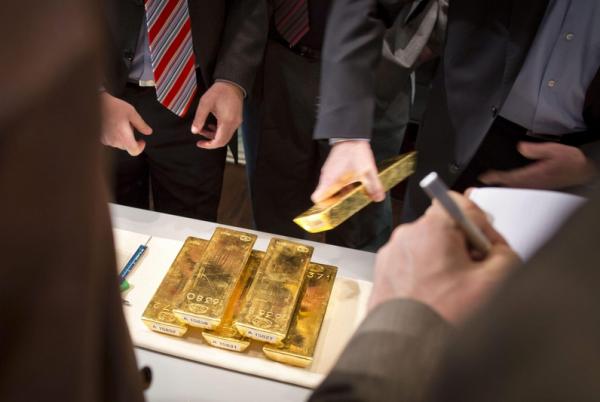Investing.com - This week precious metals traders will be focusing on Wednesday’s Federal Reserve monetary policy meeting for its impact on the U.S. dollar, which heavily influences gold’s performance.
The Fed is widely expected to deliver a quarter point interest rate hike at its meeting on Wednesday and will also update its economic projections and the dot plot of interest rate projections.
A post-policy meeting press conference by Fed Chair Jerome Powell will be closely watched. Concerns about the outlook for global growth along with trade tensions and market volatility have prompted traders to push back expectations on the expected pace of Fed rate hikes in 2019.
Gold fell to its lowest level in almost two weeks on Friday as robust U.S. economic data boosted the U.S. currency.
Gold futures settled down 0.41% at $1,242.30 on the Comex division of the New York Mercantile Exchange late Friday, after falling as low as $1,236.50 earlier. For the week, gold was down 0.89%.
The dollar rose to a 19-month high after data showed U.S. consumer spending appeared to gather momentum while industrial production rebounded in November.
Gold is often sensitive to movements in the dollar. A stronger greenback is seen as a headwind for commodities priced in dollars as it makes them more expensive to holders of other currencies.
“The key driver (of prices) in the next few sessions is going to be the markets' expectations for the Fed," said Suki Cooper, precious metals analyst at Standard Chartered Bank.
"With the Fed rate hike next week, any gold price rise will be hampered by expected dollar strength," said Ronan Manly, a precious metals analyst at Singapore-based dealer BullionStar.
Gold prices rose to a five-month peak of $1,250.55 an ounce on Monday, but has given up all the gains as the dollar strengthened against a basket of major currencies.
"With China's economy slowing, along with Germany and parts of the European Union, one would expect interest in the gold market," Walter Pehowich, executive vice president of investment services at Dillon Gage Metals, wrote in a note.
"But with the dollar being so strong ... it's going to take a major news story to bring the price of gold back in favor with investors."
Elsewhere in metals trading, silver was down 1.43% to $14.643 a troy ounce, to end the week 0.4% lower, while copper ended at $2.753, off 0.51% for the day.
Ahead of the coming week, Investing.com has compiled a list of significant events likely to affect the markets.
Monday, December 17
The euro zone is to release revised inflation data and figures on trade.
The U.S. is to report on manufacturing activity in the New York region.
Tuesday, December 18
The Reserve Bank of Australia is to publish the minutes of its latest monetary policy meeting.
The Ifo Institute is to report on German business climate.
The U.S. is to release data on building permits and housing starts.
Wednesday, December 19
The UK is to publish inflation data.
Canada is also to release its latest inflation figures.
The U.S. is to report on existing home sales.
The Federal Reserve is to announce its federal funds rate and publish updated economic projections at its last policy meeting of the year.
Thursday, December 20
New Zealand is to release data on gross domestic product and trade.
Australia is to publish its employment report.
The Bank of Japan is to announce its benchmark interest rate and publish a rate statement, which outlines economic conditions and the factors affecting the monetary policy decision.
The UK is to release data on retail sales.
The Bank of England is to announce its latest monetary policy decision.
The U.S. is to publish the weekly report on initial jobless claims and data on manufacturing activity in the Philadelphia region.
Friday, December 21
The UK is to publish revised data on GDP along with reports on net borrowing and the current account.
Canada is to report on GDP and retail sales, while the Bank of Canada is to publish its business outlook survey.
The U.S. is to round up the week with revised data on GDP, reports on durable goods orders and personal spending and revised figures on consumer sentiment.
-- Reuters contributed to this report
